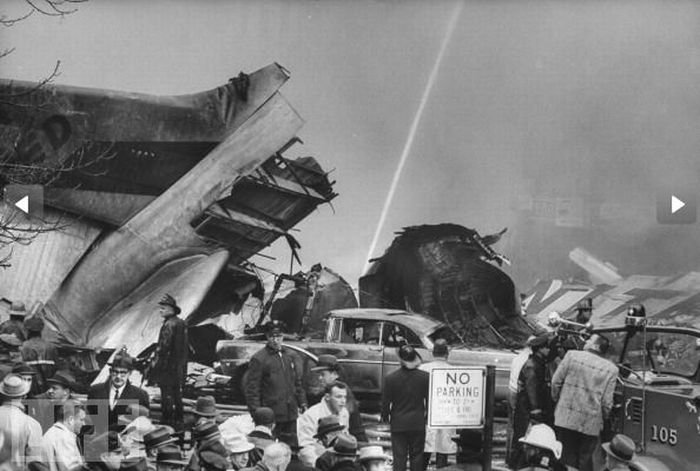|
|
History: New York Air Disaster, 1960, New York City, United States
|
At 10:21 a.m., Flight 826 advised its company radio operator that one of its VOR receivers had stopped working (although they did not notify air traffic controllers of the problem), making it difficult to navigate in instrument conditions. At 10:25 a.m., air traffic control issued a revised clearance for the flight to shorten its course to the Preston holding point by 12 miles (19 km). The United plane overshot the holding point.
The two aircraft collided in clouds about a mile west of Miller Field, a military airfield on Staten Island, at 10:33 a.m. Eastern Time. Weather conditions at the time were light rain and fog (which had been preceded by a snowfall). According to information from Flight 826's flight recorder (the first time a "black box" had been used to provide extensive details in a crash investigation), the United plane was 12 miles (19 km) off course and in 81 seconds dived 3,600 feet (1,100 m) a minute and dropped its speed from more than 500 miles per hour (800 km/h) to 363 miles per hour (584 km/h) when it collided with the right side of the TWA plane at between 5,250 and 5,175 feet (1,577 m).
The TWA Constellation crashed onto Miller Field, with some sections of the aircraft landing in New York Harbor on the Atlantic Ocean side. As it spiraled down, it disintegrated, dropping at least one passenger into a tree in the New Dorp neighborhood. It crashed into an empty field at the northwest corner of the field—within a few feet of the neighborhood. A line of khaki-clad soldiers formed at one end of the field, searching the snowy ground for "bathtubs", blood red rimmed pits where human remains littered the field. As they marched across the ground, they would shout out their discoveries, and the response was inevitably, "What have you got, a body, or a piece?" The bodies were brought back on stretchers, the pieces in bags.
Although witnesses speculated at the time that the United crew were attempting an emergency landing in Prospect Park (about 1/2 mile away) or at LaGuardia Airport, there is no evidence that the pilots had control of the DC-8 at any time after the mid-air collision. There was no audible voice radio contact with traffic controllers from either plane after the collision although LaGuardia had begun tracking an incoming fast moving unidentified plane from Preston toward the LaGuardia "Flatbush" outer marker.
|
|









